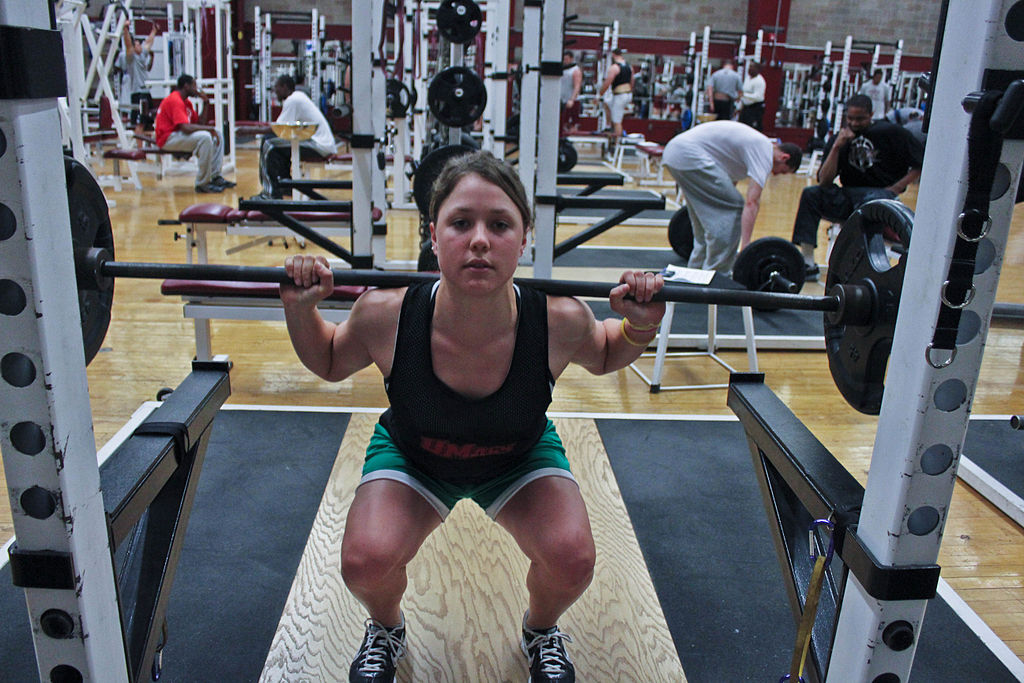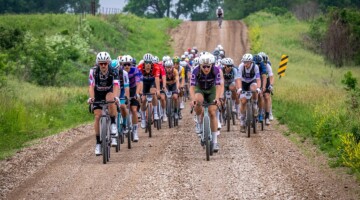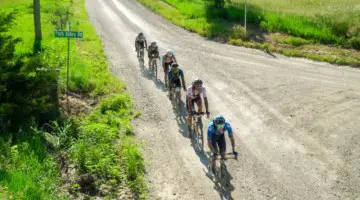As the science behind cycling training has developed, the importance of weight lifting for developing cycling skills and total body strength has as well.
For many cyclists, the thought of developing muscle can seemingly be antithetical to being as light as possible, and for others, the thought of hitting the gym might be intimidating. Our resident coach Chris Mayhew covered some of these issues in an in-depth article on the pros and cons of weight lifting for cyclists.
We wanted to revisit the issue of weight lifting for cyclists by reaching out to two experts in strength training and sports performance. What exercises should you do? How much weight? How often?
We posed those and other questions to Kenzie Green, a personal trainer at NRG Fitness in Cincinnati and Ellen Foster, a Doctor of Physical Therapy at Beyond Exercise in the same city.
Our questions and their responses are below.
If you have questions of your own, feel free to chime in in the comments. You can also follow/reach Foster on Instagram @eafost and Green on Instagram @knzgreen and via her website knzgreen.com.
Ask the Experts: Strength Training for Cyclists
CXM: First off, can you tell me a little bit about yourself?
Ellen Foster: I’m a Doctor of Physical Therapy at Beyond Exercise in Cincinnati, Ohio. I specialize in rehabilitation and performance of cyclists. I’ve worked with a wide range of local and national riders across all disciplines including Dirty Kanza 200 riders, cyclocross national champions, BMX racers, Ironman athletes and Little 500 participants.
Kenzie Green: I started racing ’cross at age 12 by joining Lionhearts Junior Racing in my hometown of Cincinnati and progressed through the program and the Ohio Valley Cyclocross series to race my first UCI elite race at age 16.
Recently, I stopped racing to focus on other areas of my life and am currently finishing up my schooling at the University of Cincinnati studying Dietetics while working as a personal trainer at NRG Fitness, a gym that taught me so much while I was growing as an elite athlete.
Through my experience in cyclocross and my personal health, I’ve grown a passion for optimizing human performance through factors like training, nutrition, recovery, and living a full life.
CXM: Should all cyclists do strength training? Just sprinters?
KG: Yes! Everyone should strength train. There are countless benefits you gain from resistance training that you don’t from endurance exercise: increasing metabolism, developing good body mechanics, effective muscle building and increase in and preservation of bone density. All cyclists, even non-sprinters, can improve their performance and overall well-being with proper strength programming.
EF: All cyclists should include strength training in their program. If you care about performance, comfort or safety, strength training can help you.

Weight lifting is beneficial for all athletes. photo: Em Bhoo, used under a Creative Commons license
CXM: What benefits does lifting provide for cyclists?
EF: Obvious benefits of stronger muscles include increased power and speed, but when done correctly strength training can prevent injuries, improve biomechanical efficiency, decrease pain and make you a more confident and safer rider.
KG: Let’s think about this by discussing how strengthening certain areas can affect your performance on the bike, not including the general benefits to your quality of life that strength training can provide.
Strengthening the core provides a good base for you to drive your power from. Power to the pedals originates from the hips and stabilizing your core to support your hips and source of power makes pedaling more efficient. Some of the muscles that are key for this support would be the lower abs (below the belly button, which can also relieve some pressure from the lower back), transverse abdominis and most muscles in your back.
I challenge most cyclists to make sure they are activating the proper muscles by aiming for back flexion when working their core since many ab exercises can rely on hip flexor movement and many cyclists struggle with already tight hip flexors.
Strengthening the mid to upper back along with shoulders and arms allows cyclists to hold proper form on the bike and keep their hands lighter on the handlebars. This is a common place for form breakdown in cyclists, especially on longer rides. Any break in form on the bike can radiate through the body and weaken the pedal stroke, which is definitely something to avoid since we want to increase our power output in any way we can.
We can build strength in our legs in a couple different ways depending on the goal, but this can do everything from improving power, increasing resilience and improving recruitment patterns. Strengthening lateral movements and “balancing” muscles like our adductors and abductors can take some responsibility from strong muscles like the quads. This allows the “balancing” muscles to keep your knee in line while your power muscles like your quads and hamstrings can focus on creating power.
A huge benefit of strength training is the ability to target “sleepy” muscles. Perhaps you sit at work or school or day and have trouble engaging your glutes while pedaling. Your glutes are big muscles and a great source of power, so we can “wake them up” by improving the mind to muscle connection through specific exercises for your glutes. This idea can be applied to everyone’s unique body to make sure everything is functioning properly for optimal performance.
CXM: What exercises do you recommend?
KG: It always depends based on someone’s goal. An elite athlete would get a different program than someone who rides for fun and whose primary goal is being healthy and functional for life. A mountain biker would also get different exercises than a road racer. It’s important to understand that everyone is an individual and should be treated as so, which is why I keep stressing that point.
That said, some exercises that I would recommend to the average cyclist include: squats, split squats, deadlifts, single leg deadlifts, side lunges, glute bridges, lat pulldown, bent over row, upright row, push-ups, reverse crunches, planks (with your pelvis rotated under like a dog tucking its tail), rotational resistance exercises, vacuums, dead bugs and Russian twists.
EF: It depends on your goal and what aspect of your riding you are trying to improve. The most basic exercises are squats, deadlifts and lunges. There are so many variations of these I love, including single leg variations such as pistol squats and single leg Romanian dead lifts.
If these sound intimidating to you, a good therapist or trainer will be able to scale down any exercise appropriately. If you struggle with bike handling or balance, training core stabilization off the bike will be wildly helpful. Bird dogs, dead bugs, planks and the Palloff press are some of my favorites for training coordination of core with upper and lower body movement. Most of these movements will have the side effect of improving shoulder stability and rotator cuff strength.
[Ed Note: Our experts stressed the importance of working with a professional for learning how to do exercises. However, some online resources they recommended are MoveU, Squat University and Dr. Jacob Harden.]
CXM: Should you do heavy weight-low reps, low weight-high reps or a mix?
EF: Both, at different times during a training cycle. To increase power, you need to lift heavy. Some of our athletes’ sessions will be focused on high force / low velocity, while other sessions will be low force / high velocity. Other sessions will focus on core stabilization and use very little weight but will still be very challenging.
KG: Definitely a mix. Just like you would phase your intervals and do a mix of long intervals and short sprint intervals, you should do the same with your strength training. Phases of heavy weight / low reps allow you to effectively build strength and muscle, while phases of lower weight and higher reps build strength and endurance. A low weight / high reps program is the way to go during race season to maintain full body strength while keeping your endurance up for races.
CXM: Are different exercises better for different skills?
KG: Yes! There are some exercises for your upper body (upright row, suitcase row) that translate directly to the suitcase carry of your bike for running over barriers or upstairs. Core balancing exercises will help you stay off the saddle while gliding through sand or mud. Leg balancing exercises like standing one-legged on a Bosu ball will increase your stability for running through mud.
EF: Yes. Some exercises will be focused on power generation, some will focus on biomechanical efficiency, some will focus on motor coordination. I prescribe different exercises depending on an athlete’s needs.
Also, just because you can successfully perform the same circus trick exercise as your favorite world champ mountain biker or WorldTour racer, doesn’t mean that you are utilizing the exercise effectively. There are many foundational exercises that will provide greater benefit and are safer. Standing on a Swiss ball isn’t going to get you that local KOM/QOM if you can’t perform a bodyweight squat with proper technique.
CXM: With respect to the riding season, when should you lift weights? Just offseason? During the season?
EF: Strength training should be periodized and adjusted depending on your training block and training age—number of years consistently training. A more experienced athlete will be able to tolerate more than an inexperienced athlete, but during an offseason/building phase, strength training two to three times per week is effective. The frequency may decrease to one or two times per week during your race season for strength maintenance.
KG: Ideally all year long. As I mentioned earlier, you phase weightlifting in a similar way that you would phase intervals and on-the-bike training. A general way to look at it is to use the offseason for building strength and lifting heavy and do more maintenance work during the racing season.
“Maintenance” can mean higher reps with lower weights, more mobility or isometric work or correctional exercises—whatever your body needs at that time.
CXM: Should you lift weights on days you ride? What is the best way to incorporate lifting into a typical week of riding?
KG: It depends. Regularly lifting weights on hard interval days isn’t a great idea and will be hard to recover from. In a typical week of riding with Monday off, intervals Tuesday through Thursday and racing or long rides on the weekends, Monday and Friday will be great days to incorporating strength training. If you have an easier day without intervals between Monday and Friday, that would be a great day to add in a third day of strength training if you’re looking to lift more.
EF: Riding should always be your primary workout and strength training or cross-training is secondary. This means what you do in the gym shouldn’t negatively impact your planned ride for the day. You don’t want to miss your training zones because your legs are sore or fatigued. One strategy is to simply lift later in the day after you ride in the morning. An experienced cycling coach will be able to include strength sessions in your weekly plan.
CXM: What mistakes do you commonly see athletes make when adding lifting to their training?
EF: 1. Not having a baseline assessment of strength and mobility administered and therefore not having a customized program. You will see the most benefit when a strength program is tailored to your specific limitations and deficits. You might see results with a cookie-cutter program, but you can get results so much faster by targeting your weaknesses and fixing your asymmetries. This includes not properly rehabbing injuries prior to introducing strength work.
2. Going along with the above, not addressing mobility and neuromuscular control. Strength training isn’t just about moving heavy weight. All athletes should include exercises that improve their stability, balance, and single leg control.
3. Not using a cycling-specific strategy. It’s easy to find structured plans online that are meant for hypertrophy and aesthetics but do little to help with cycling performance.
4. Being afraid or believing lifting weight is dangerous or too technical. Everyone can learn how to squat, deadlift, and lunge safely.
5. Not strength training. Whether you think it’s not useful for a Cat 5 (it is) or it’s dangerous for Juniors (fake news). At the very least, try strength training just once a week and you will see results.
KG: Going too hard too fast, not emphasizing form, and doing online programs that don’t compliment their cycling.
Athletes tend to get excited and enjoy pushing their body, which can spell trouble if you haven’t lifted before and suddenly start doing hard strength workouts five days a week. Your body will get overwhelmed, have difficulty recovering and before you know it, you’ve done more harm than help to your body.
Form is king. If you don’t have proper form, you aren’t doing the exercise. If your form fails during an exercise, your body isn’t recruiting the target muscles anymore and you should stop the exercise. Either check your form and maintain it or stop and move on if you truly can’t keep your form anymore.
I cannot stress this enough. Poor form means you aren’t getting the benefit of your hard work anymore and leads to imbalances and injuries.
The last mistake that is incredibly common is following a program they found for free online. You are an individual with a different body than your neighbor, teammate and the person who wrote that program. What worked for them may not work for you.
Finding a free online program that compliments your cycling training, takes into account your physical needs and checks you on your form is impossible. Save yourself from the headaches and possible harm and find a professional who can properly assess you and give you a program that will help you reach your goals.
CXM: If athletes do not have a gym membership, how can they add lifting at home?
KG: Get creative. There are plenty of bodyweight exercises that will benefit you and be better than avoiding strength training completely. Lack of access to machines and weights means you can stick to the basics and get creative by using household items like your couch or coffee table like a bench to do exercises like tricep dips, Bulgarian split squats or incline push-ups.
If you really want to use some weight, a couple dumbbells you ordered off Amazon can take your at-home routine to the next level. If you don’t want to buy anything but still use weights, you can use a gallon jug of water, a heavy book or maybe a small dog (joke, unless they’re incredibly tolerant).
EF: The most basic equipment I recommend: several kettlebells or plates (5lb, 10lb, 15lb, 20lb), resistance band loops, furniture sliders and a mirror. It’s best to have a few in-person sessions with a physical therapist, trainer or sports chiropractor to learn proper form, but once you have good technique, home workouts can be just as beneficial.
Featured image: Flickr user slgcckgc, used under a Creative Commons license




























